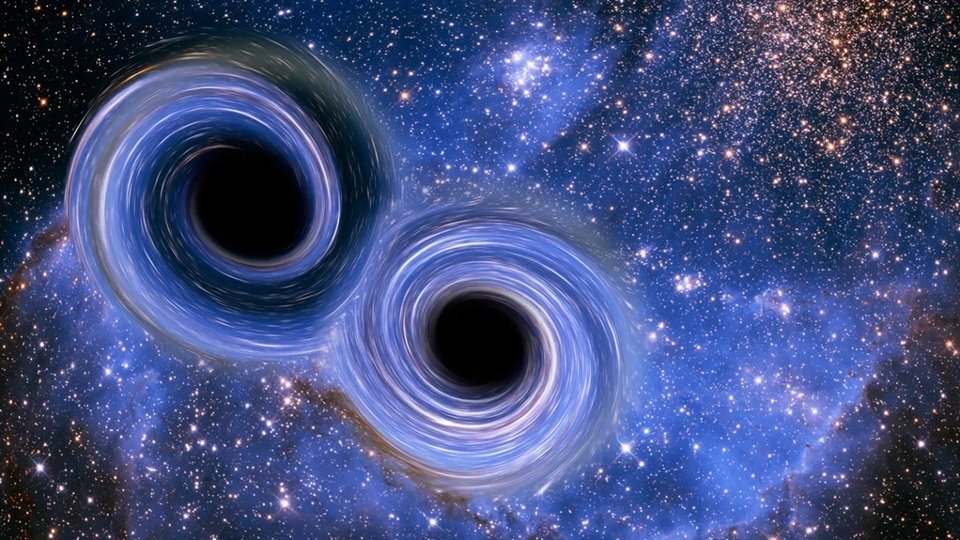The biggest black hole smashup ever detected challenges physics theories
Talk about epic. A collision of two black holes is so extreme that it’s...The biggest black hole smashup ever detected challenges physics theories
Talk about epic. A collision of two black holes is so extreme that it’s challenging physics theories of how large black holes form and merge.
The two black holes had masses bigger than any before confirmed in such a collision. One had about 140 times the mass of the sun, and the other about 100 solar masses. And both were spinning at nearly the top speed allowed by physics.
“We don’t think it’s possible to form black holes with those masses by the usual mechanism of a star collapsing after it has died,” says physicist Mark Hannam of Cardiff University in Wales, a physicist working on the Laser Interferometer Gravitational-Wave Observatory, or LIGO, which detected the crash. That has researchers considering other black hole backstories.
Scientists deduced the properties of the black holes from shudders of the fabric of spacetime called gravitational waves. Those waves were detected on November 23, 2023, by LIGO’s two detectors in Hanford, Wash., and Livingston, La.
The two black holes spiraled around one another, drawing closer and closer before coalescing into one, blasting out gravitational waves in the process. The merger produced a black hole with a mass about 225 times that of the sun, researchers report in a paper posted July 13 at arXiv.org and to be presented at the International Conference on General Relativity and Gravitation and the Edoardo Amaldi Conference on Gravitational Waves in Glasgow, Scotland, on July 14. The biggest bang-up previously confirmed produced a black hole of about 140 solar masses, researchers announced in 2020. In the new event, one of the two black holes alone had a similar mass.
Black holes with masses below about 60 times that of the sun are formed when a star collapses at the end of its life. But there’s a window of masses for black holes — between about 60 to 130 solar masses — where this mechanism is thought not to work. The stars that would form the black holes in that mass range are expected to fully explode when they die, leaving behind no remnant black hole.
For the newly reported black holes, uncertainties on the mass estimates mean it’s likely that at least one of them — and possibly both — fell in that forbidden mass gap.
The prediction of this mass gap is “a hill at least some people were willing to get wounded on, if not necessarily die on,” says Cole Miller of the University of Maryland in College Park, who was not involved with the research. So, to preserve the mass gap idea, scientists are looking for other explanations for the two black holes’ birth.
One possibility is that they were part of a family tree, with each black hole forming from an earlier collision of smaller black holes. Such repeated mergers might happen in dense clusters of stars and black holes. And they would result in rapidly spinning black holes, like the ones seen.
Every black hole has a maximum possible spinning speed, depending on its mass. One of the black holes in the collision was spinning at around 90 percent of its speed limit, and the other close to 80 percent. These are among the highest black hole spins that LIGO has confidently measured, Hannam says. Those high spins strengthen the case for the repeated-merger scenario, Hannam says. “We’ve seen signs of this sort of thing before but nothing as extreme as this.”
But there’s an issue with that potential explanation, Miller says. The black holes’ masses are so large that, if they came from a family tree, that tree might have required multiple generations of ancestors. That would suggest black holes that are spinning fast, but not quite as fast as these black holes are, Miller says. That’s because the black holes that merged in previous generations could have been spinning in a variety of different directions.
An alternative explanation is that the black holes bulked up in the shadow of a much bigger black hole, in what’s called an active galactic nucleus. This is a region of a galaxy surrounding a centerpiece supermassive black hole that is feeding on a disk of gas. If the black holes were born or fell into that disk, they could gobble up gas, ballooning in mass before merging.
Here, the spin also raises questions, Miller says. There’s a hint that the two black holes that merged in the collision weren’t perfectly aligned: They weren’t spinning in the same direction. That conflicts with expectations for black holes all steeping in the same disk.
“This event doesn’t have a clear and obvious match with any of the major formation mechanisms,” Miller says. None fit perfectly, but none are entirely ruled out. Even the simplest explanation, with black holes formed directly from collapsing stars, could still be on the table if one is above the mass gap and the other is below it.
By Emily Conover @ Science News
www.sciencenews.org/article/biggest-black-hole-gra…
Show more


